Chimaphila maculata
Little evergreen plant with eye-catching white stripes and veins on its leaves
Chimaphila maculata spotted wintergreen
Striped wintergreen is a low, evergreen perennial found in dry, acidic woodlands across eastern North America. It grows from underground stolons and fibrous roots, often forming small colonies. The plant reproduces by seed (especially after light wildfires) and also vegetatively from an underground stem. Stems are semi-woody, slender, and red to brown in color, typically unbranched. Non-flowering plants are 3–5 inches tall while flowering stems with inflorescences reach 6–10 inches.
Leaves are leathery, evergreen, and distinctive with a white stripe along the midvein. They measure 1–3 in. long and 1⁄4–1 in. wide, lance-shaped to ovate, with widely spaced toothed margins. Upper surfaces are dark green with pale venation and undersides are light green. Two opposite pairs of smaller leaves occur near the stem base, and a whorl of three larger leaves forms just below the inflorescence. The leaves have a refreshing taste when chewed.
Flowering stems terminate in nodding clusters of 1–5 fragrant, waxy flowers. Each bloom is 1⁄2–3⁄4 inches across, with 5 rounded white to pinkish petals (often with small brownish spots) that curve backward, 5 light green sepals, 10 stamens that form a crown in the center with showy pink anthers, and a green knobby pistil. Flowers face downward on recurved stalks. Blooming occurs from late June into August, lasting 2–3 weeks. The flowers take several weeks to open from the bud stage.
Habitat & Range
Common in shaded woodland environments, especially under pine and oak canopies. Prefers part to full shade in well-drained, acidic soil often sandy or loamy.
Present throughout the state except northernmost counties.
Range: Native from southern Ontario through the eastern and southeastern United States into Mexico and Central America, and is especially found in highland forests from Michigan southward.
Wetland Code: Not classified
Phenology
Flowers June to early August; buds take a few weeks to fully open. Blooming period is 2 to 3 weeks.
Characteristics
Inflorescence nodding umbels of 1 to 5 flowers
Flowers waxy, white to slightly pink rounded petals with brown spots; petals curve backward; recurved stalks hold flowers face-down; 5 light green sepals; 10 stamens with pink anthers; 1 green knobby pistil; ½ to ¾″ wide
Leaves lanceolate to ovate; evergreen, leathery; opposite near stem base, a whorl of 3 larger leaves below flowers; widely spaced teeth (dentate); bold white stripes and thin white veins; 1-3″ long, 1⁄4–1″ wide;
Stems red-brown, semi-woody; unbranched flowering stems; spreads by underground stolons
Fruit dehiscent rounded capsule, abt. 1⁄3″ across, dark brown at maturity; seeds numerous, very fine and dust-like
Height 3 to 10 inches ( 3 to 5 inches when vegetative, flowering 6 to 10)
Identification Tips
Evergree, lanceolate leaves have a white midrib stripe on each leaf.
Flowers on recurved pedicels face downward.
Plant Codes
S-rank: S5 (Secure)
G-rank: G5 (Secure)
Ecology
Flowers are cross-pollinated primarily by bumblebees and other bees seeking nectar. The foliage contains tannins and is generally avoided by deer and other mammals and has been reported as toxic to sheep.
Striped wintergreen depends on mycorrhizal fungal partners for seedling establishment, making its survival closely tied to intact forest ecosystems.
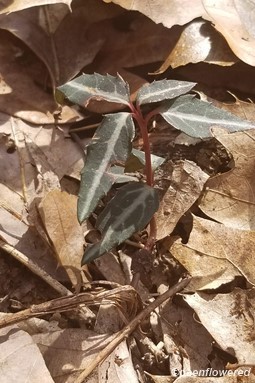
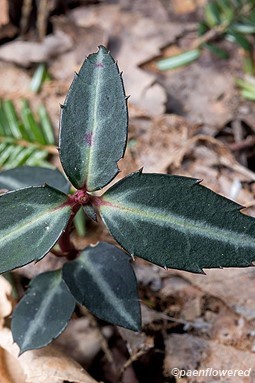
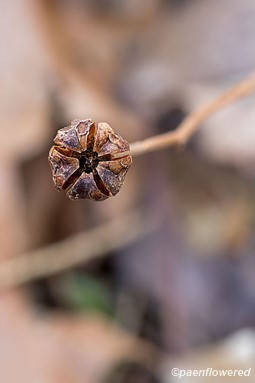

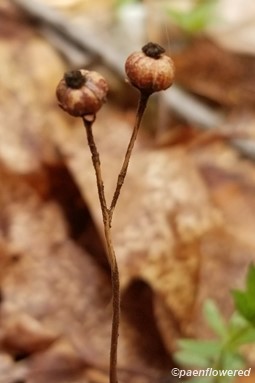
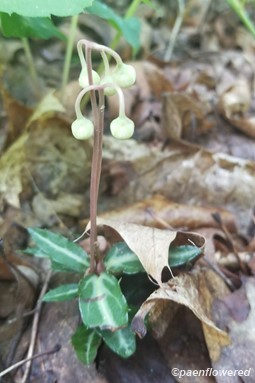
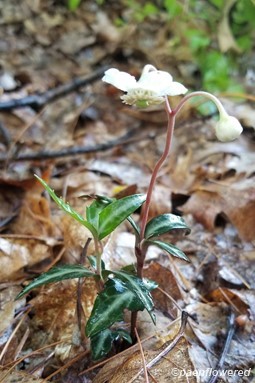
_©DaveSpier_KingsGapSP,PA_7-7-05.JPG?v=638575343750000000)

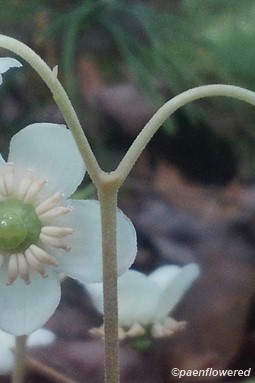

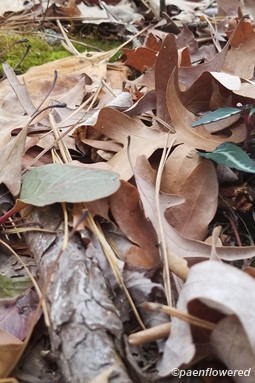
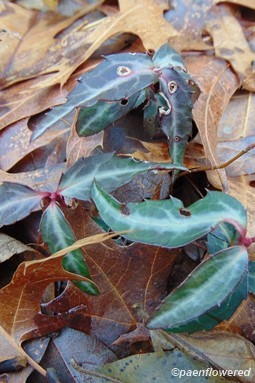


Comments
Have you spotted this plant in your area? We'd love to hear about your experience! Share your comments or questions about the plant below. Comments are moderated before posting.